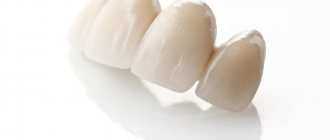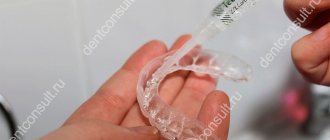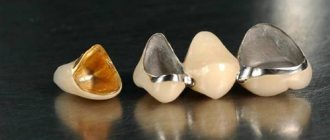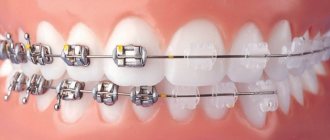Reasons for chipping ceramics in metal-ceramic structures
At the junction of the metal frame of the denture and the ceramic coating, strong stresses often arise, which in stressful situations lead to the formation of cracks, chips or spalls in the ceramics.
The main reasons for ceramic chipping are:
- Mismatch between the thermal expansion coefficients of ceramics and the metal alloy from which the frame is made.
- Unreasonable choice of metal ceramics as a material for a fixed prosthesis in some patients (for example, those suffering from bruxism).
- If the intermediate part of a metal-ceramic bridge is too long, the frame of which is made of precious alloys (which have lower rigidity than non-precious alloys), chewing loads on it can lead to chipping of the veneer.
- Incorrect tooth preparation, for example, insufficient taper, can lead to stress in the framework of the metal-ceramic crown and subsequent chipping of the veneer.
- Chips often occur when performing orthopedic work (especially large-scale ones) without an articulator and a facebow.
- When fixing a metal-ceramic prosthesis with excessively thick cement, or when foreign bodies get between the tooth stump and the crown.
- Chips may be a consequence of incorrect modeling of the metal-ceramic frame of the future prosthesis:
- insufficient height of the frame, which necessitates the layering of an excessive amount of ceramics - unmodeled tooth relief - non-compliance with the technology of mechanical and chemical processing of the metal frame - holes in the metal frame, which technicians close with ceramics. Subsequently, after cementing the crowns, tension arises here, since the cement presses evenly on all walls and later a chip forms in this place and rapid decementing of the structure.
If you have a problem similar to that described in this article, be sure to contact our specialists. Don't diagnose yourself!
Why you should call us now:
- We will answer all your questions in 3 minutes
- Free consultation
- The average work experience of doctors is 12 years
- Convenient location of clinics
Single contact phone number: +7
Make an appointment
- The cause of chipping may be stress in the ceramics or metal frame, resulting from non-compliance with technological rules for working with ceramics:
- overheating of the metal during firing of ceramics - violation of temperature relationships during successive firing and cooling of ceramics - violation of the rules for working with ceramic masses offered by manufacturers - non-compliance with ceramic processing technology.
- Careless or careless handling of the patient with prosthetic metal-ceramic structures. The fragility of ceramics under inadequate loads, and less often during sudden temperature changes, should be taken into account. We also recommend that you read the article about installing ceramic crowns at 32Dent dentistry.
What is a metal-ceramic crown?
Today, the choice of materials for making dental crowns is very wide: ceramics, zirconium dioxide, and plastic, but metal-ceramics continues to be the most popular and affordable. At the moment, metal ceramics are a kind of gold standard in dentistry, since similar designs have been used by doctors for many years and have proven themselves to be good.
Metal-ceramic crowns are a “cap” with machined fissures, which is placed on a ground tooth and completely imitates its shape, including all anatomical formations. The basis for the structure is a metal frame, which is covered on top with a layer of ceramics, indistinguishable in color from natural enamel. The prosthesis is secured to the ground dental tissues using special composite or glass ionomer cement. In case of severe destruction, a metal tab is first installed, which serves as a reliable basis for the crown. Metal-ceramics are also used for the manufacture of bridges and clasp dentures supported both on the patient’s own teeth and on dental implants. In the latter case, the use of implants with metal abutments is recommended.
Flaws
The disadvantages of metal-ceramics are mainly due to the thickness of the prosthesis. The metal frame and ceramic layer force the dentist to sharply grind the tooth. Therefore, dental units subject to prosthetics are first subjected to endodontic treatment. This is undesirable for a healthy tooth, since depulpation makes it more fragile.
Dental prosthetics with products is not recommended for children under 16 years of age due to the thin enamel-dentin layer and the close proximity of the horns of the pulp chamber, which means depulpation will inevitably be required.
The ceramic mass completely covers the metal base, with the exception of a small gap on the lingual side. The open metal part (“garland”) can cause discomfort in the oral cavity, and in cases where the patient already has other metal dentures, galvanization phenomena are possible.
In the frontal area, products made from MC may not look very natural, so here it is advisable to do prosthetics with all-ceramic crowns.
Pros and cons of a metal-ceramic crown
Among the advantages of metal-ceramic crowns is, first of all, their strength. Therefore, in most cases they are installed on chewing teeth. Undoubtedly, they look much better than purely metal crowns. In general, metal-ceramic crowns imitate real teeth well, but with the advent of new materials in prosthetics, preference in restoring anterior teeth began to be given to all-ceramic structures. When a combination of reliability and aesthetics is needed in the chewing area, then the best choice would be ceramic prostheses based on zirconium dioxide.
Make an appointment
right now!
Akhmedkhanov Said Rashidovich
Surgeon, Therapist, Orthopedist, Hygienist, Implantologist
What are the differences between metal-ceramic crowns?
Indeed, many patients wonder: what is better - zirconium crowns or metal-ceramics? Roughly speaking, both structures are metal-ceramic, but zirconium is a “white” material that does not shine through the ceramic, as sometimes happens with ordinary metal. Therefore, today ceramic crowns on a zirconium frame are close in aesthetic qualities to all-ceramic crowns, but at the same time they have the same strength as metal-ceramics. However, prices for such prostheses are higher than for metal-ceramic structures without the use of zirconium.
The question of which is better - metal-ceramic or ceramic crowns cannot be answered unequivocally. The choice is made depending on the indications and budget. So, if prosthetics of the frontal group of teeth is necessary, it is recommended to choose solid ceramics. It is aesthetic metal ceramics. Typically, such crowns are placed on teeth where the chewing load is less, since the metal-ceramic frame is stronger. Regarding the issue of price, a metal-ceramic crown is, of course, cheaper.
Features of prosthetics of anterior and chewing teeth
Metal-ceramic orthopedic systems are used to replace any group of teeth. Installation of metal ceramics on the front incisors takes into account the characteristics of the frontal zone. Impeccable aesthetics will be ensured by a frame made of precious metals. To avoid a blue margin at the gingival margin, dentures with a shoulder mass or shoulder are used. The designs have an increased ceramic layer; the cladding does not end at the base, but is folded over to cover the metal. This improves the aesthetics of the orthopedic system in the cervical area - the metal does not show through the gum, the prosthesis looks natural even when the gingival margin subsides.
Prosthetics of molars is performed using standard technology - strength and functionality are important for the chewing zone, aesthetics takes second place here.
Types of metal-ceramic crowns
Metal-ceramic crowns have several classifications: according to the frame material and according to the ceramic material. Thus, according to the frame material, crowns are distinguished based on a chromium-nickel alloy, based on a cobalt-chromium alloy, and based on a gold-platinum (palladium) alloy (based on the so-called “noble alloys”). There is also another material that is used quite rarely - titanium alloy. Each of these types of metal-ceramic crowns has its own pros and cons. Traditionally, the most popular material is cobalt-chromium alloy. Based on the ceramic material, a distinction is made between conventional (high-temperature) and low-temperature ceramics. Low-temperature ceramics based on “noble” alloys look more aesthetically pleasing.
Indications and contraindications for metal-ceramic crowns
The indications for installing a metal-ceramic crown are the same as for crowns made of other materials. The main one is the index of destruction of the coronal surface of the tooth, equal to 0.6. Also, indications for installing a metal-ceramic crown are:
- any non-carious lesions, for example, fluorosis or enamel hypoplasia;
- abnormal development and position of the front teeth in adults, which for any reason cannot be eliminated by orthodontic methods;
- pathological abrasion or wedge-shaped defect;
- aesthetic defect in the crowns of natural teeth (changes in color and shape, loss of shine, etc.);
- inconsistency of existing artificial crowns with aesthetic and functional requirements;
- metal-ceramic crowns can also be used as a splinting structure for mild to moderate periodontitis;
Each of the above indications should be considered in the context of a specific clinical case. Contraindications include, for example, bruxism, as well as periodontitis, accompanied by severe tooth mobility. In addition, fixed prosthetics on implants also involves the use of metal-ceramic crowns.
Is it possible to put metal-ceramic crowns on the front teeth?
It is possible if the patient’s budget does not allow for all-ceramic crowns. There are no medical contraindications to the manufacture of metal-ceramic crowns on the frontal teeth. However, aesthetics in this case recedes into the background. Such crowns will not look very natural. Therefore, it is still better not to place metal-ceramic crowns on the front teeth.
Is it possible to remove the prosthesis?
Many patients are concerned about the question of whether it is possible to remove a metal-ceramic single prosthesis and how to do it. Installing a crown is a permanent type of prosthetics, but this only means that the patient will not be able to remove it on his own. A dentist can remove a fixed structure, and usually this measure is resorted to when suspicious symptoms of a pathological process occur: an unpleasant odor, penetration of food debris, mobility.
If there is no need to maintain the integrity of the product, it can simply be sawed - this is an old and proven method. Also for this procedure, the “Koppa” apparatus is used - this is a special instrument shaped like a small pistol. With its help, the specialist grinds off the cement at the base, after which he carefully picks up the structure and removes it. Some clinics use ultrasound to destroy the binding properties of cement, but it is not always effective. There is also the Coronaflex device, which is based on the principle of exposure to compressed air - an air flow under high pressure destroys cement without damaging the orthopedic product.
Installing a metal-ceramic crown on a tooth
- The first stage of installing a metal-ceramic crown can be called clinical. The doctor treats the tooth and its canals, prepares dental tissue for the future crown and takes an impression.
- After this, the laboratory stage begins: in the laboratory, a crown frame is made, which we then try on, check its reliability and fit to the tooth, correct defects, if any, and also choose the color of the future structure. The frame is then taken back to the laboratory, where a technician applies ceramic paste to it.
- When the crown is ready, the doctor invites the patient to an appointment and installs it.
While the prosthesis is being manufactured, which can last from one to two weeks, a temporary crown is installed on the tooth.
Metal-ceramic crown with shoulder
There are no metal-ceramic crowns with a shoulder. The tooth is ground with a shoulder, and the metal-ceramic crown is made with a ceramic shoulder. That is, the edges of the metal frame of the crown are lined with a special “shoulder” ceramic mass. This is done to improve the aesthetics of prosthetics with metal-ceramic crowns, as well as to prevent “cyanosis” (translucency of the metal frame) in the crown-tooth transition zone.
Service life of metal-ceramic crowns
How long does a metal-ceramic crown last? Modern products last on average about 10 – 12 years. If a chip occurs on the metal-ceramic crown of the ceramic layer, then in some cases repair is possible. If it did not occur due to the development of secondary caries under the prosthesis, but as a result of mechanical damage, the dentist assesses the volume of the chip and, if the metal frame is not exposed, restoration of the metal-ceramic crown can be carried out using grinding or composite materials. If a serious chip occurs on the metal-ceramic crown, the prosthesis must be replaced.
Once the service life of the prosthesis has expired, the structure must be replaced. This is due to the fact that the special cement on which the structure is attached begins to deteriorate over time under the influence of saliva and other factors. If the crown is not removed in time, a problem may arise such as secondary caries, developing under the cap and at its junction with the tooth tissue.
Design Features
Orthopedic systems made of metal-ceramics have a reliable frame made of a metal alloy, lined with ceramic mass, close in color to natural enamel. The coating is applied in layers - each layer is exposed to high temperature (baked). This ensures strong adhesion of materials and good aesthetics of the prosthesis - the risk of chipping the lining is reduced to zero.
Caring for metal-ceramic crowns
The rules for caring for metal-ceramic crowns are practically no different from the rules for caring for natural teeth. However, less interdental plaque and tartar are formed on the metal-ceramic surface than on natural enamel. For care, it is necessary to use dental floss, brushes and, preferably, an irrigator to avoid the accumulation of plaque at the transition boundary from the crown to the tooth. During the professional hygiene procedure, the structure must be polished. Otherwise, timely attendance at preventive examinations and thorough daily cleaning will help the metal-ceramic crown serve its full service life.
How much do metal-ceramic crowns cost in Moscow?
The price of metal-ceramic crowns per tooth depends on the price category of the clinic in Moscow, the metal used to make the frame, the qualifications of the prosthetist and dental technician, the complexity of the clinical case and a number of other factors. The price of a metal-ceramic crown for one tooth starts from 7,000 rubles. However, it does not include additional costs. The total cost of a dental crown made of metal ceramics, including taking impressions, installing a temporary crown and fixing a permanent one, is about 10,000 rubles, which, in general, is very inexpensive in Moscow.
Publisher: Expert magazine about dentistry Startsmile.ru
Guarantee
As with any other types of dentures, each clinic provides a guarantee for metal-ceramics for teeth. Of course, its duration is short, and how long the guarantee for metal-ceramics lasts depends mainly on the decision of the management of dentistry. What kind of warranty is usually provided? This is a period of one to three years during which you can see a doctor for free repairs to your prosthesis. Considering that structures made from this material are recommended to be replaced after 5-7 years, such a guarantee can be called acceptable.









